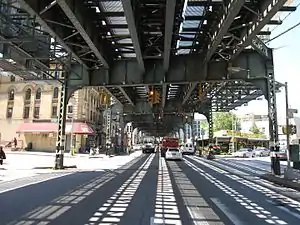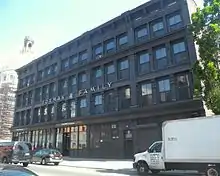Broadway (Brooklyn)
Broadway is an avenue in the New York City borough of Brooklyn that extends from the East River in the neighborhood of Williamsburg in a southeasterly direction to East New York for a length of 4.32 miles (6.95 km). It was named for the Broadway in Manhattan. The East New York terminus is a complicated intersection with East New York Avenue, Fulton Street, Jamaica Avenue, and Alabama Avenue. The BMT Jamaica Line (J, M, and Z trains) of the New York City Subway runs on elevated tracks over Broadway from the Williamsburg Bridge to East New York on its way to Queens. Broadway forms the boundary between the neighborhoods of Bushwick, which lies above Broadway to the northeast, and Bedford–Stuyvesant, which is to the southwest.
 Broadway at Union Avenue | |
| Owner | City of New York |
|---|---|
| Maintained by | NYCDOT |
| Length | 4.4 mi[1] (7.1 km) |
| Location | Brooklyn |
| Postal code | 11211 11206 11221 11207 |
| Nearest metro station | Jamaica Line Broadway |

History
When Williamsburg was an independent city, the length of Broadway from the East River to South 6th St was known as South 7th St. From that point to Division Ave, it took over the path of South 6th St. Both of these segments opened in the 1830s. From that intersection to its terminus in East New York it was named Division Ave,[2] which was laid on the municipal boundaries separating the city of Brooklyn from the town of Bushwick (and village of Williamsburg, which was then part of the town). At each of the roadbed changes in Williamsburg, Broadway bends a little more to the south until it runs straight southeast to East New York.
The Broadway Ferry provided service (from the early 19th century) from the foot of Broadway to several points in Manhattan and by the mid-1860s was carrying over 200,000 passengers per day.[3] The ferry terminal was linked first to streetcars and then elevated rapid transit in 1889.[4] With these connections, the central commercial area of Williamsburg began to migrate to Broadway from Grand Street.[3] This was further spurred by the opening of the Williamsburg Bridge although the section of Broadway from the new bridge plaza to the ferry landing river declined since it was now effectively bypassed.[5] Prominent extant buildings in Williamsburg located on Broadway include The Williamsburgh Savings Bank (at #175, built in 1875), Nassau Trust Company (at #134-136, built in 1888), Kings County Savings Bank (#135, built in 1868), Peter Luger Steak House (at 178, built in 1876), and several cast iron buildings such as the Sparrow Shoe Factory (#195, across Driggs Avenue from Williamsburgh Savings, built in 1882).[6][7]
During the New York City blackout of 1977, Broadway was the epicenter and worst hit of the looting, rioting, and violence that hit the city. Thirty-five blocks of Broadway from Williamsburg to Bedford-Stuyvesant were destroyed, 134 stores looted, 45 of them set ablaze. The riots accelerated white flight from the area, as many of the destroyed properties were never rebuilt and remained empty lots well until the 1980s.[8][9] Broadway remained a high-crime, destitute area until gentrification in the 2000s which has initiated a resurgence of new businesses, construction of luxury condominiums, and a return of chain stores to the area. In 2019, the New York City Department of City Planning released a Bushwick rezoning plan, which would allow for high-density development on Broadway and Myrtle and Wyckoff Avenues.[10]
References
| Wikimedia Commons has media related to Broadway (Brooklyn). |
- Google (February 22, 2017). "Broadway (Brooklyn)" (Map). Google Maps. Google. Retrieved February 22, 2017.
- Bernardo, L. & Weiss, J. (2006). Brooklyn by name. New York: NYU Press
- "NEIGHBORHOOD AT RISK: WILLIAMSBURG". Archived from the original on 2007-02-07. Retrieved 2011-06-14.
- Cudahy, B.J.(1990). Over and back: The history of ferryboats in New York harbor. New York: Fordham University Press
- New York Times, Traffic Changes in Williamsburg, June 25, 1911
- White, N. & Willensky, E. (2000). AIA Guide to New York City (4th Ed.). New York: Three Rivers Press
- 195 Broadway, originally Sparrow Shoe Factory Warehouse NYC-Architecture.com
- Hogan, Gwynne (July 13, 2017). "40 Years Since Blackout, Bushwick's Broadway Still Struggles to Swing Back". DNAinfo New York. Archived from the original on April 16, 2019. Retrieved July 18, 2019.
- Gottlieb, Martin (July 17, 1984). "BUSHWICK, A SHAMBLES IN '77, SHOWING SIGNS OF RECOVERY". The New York Times. Retrieved July 18, 2019.
- Spivack, Caroline (April 24, 2019). "Vision to rezone Bushwick unveiled by city". Curbed NY. Retrieved July 18, 2019.